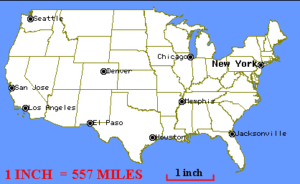Proportions
Learning Outcome
- Define and write a proportion
- Solve proportion problems
 Matryoshka or nesting dolls.
Matryoshka or nesting dolls.[latex]\frac{12\text{ drinks }}{1\text{ package }}[/latex]
Then we express the number of people who we are buying drinks for as a ratio with the unknown number of packages we need. We will use the maximum so we have enough.
[latex]\frac{40\text{ people }}{x\text{ packages }}[/latex]
We can find out how many packages to purchase by setting the expressions equal to each other:
[latex]\frac{12\text{ drinks }}{1\text{ package }}=\frac{40\text{ people }}{x\text{ packages }}[/latex]
To solve for x, we can use techniques for solving linear equations, or we can cross multiply as a shortcut.
[latex]\begin{array}{l}\,\,\,\,\,\,\,\frac{12\text{ drinks }}{1\text{ package }}=\frac{40\text{ people }}{x\text{ packages }}\\\text{}\\x\cdot\frac{12\text{ drinks }}{1\text{ package }}=\frac{40\text{ people }}{x\text{ packages }}\cdot{x}\\\text{}\\\,\,\,\,\,\,\,\,\,\,\,\,\,\,\,\,\,\,\,\,\,\,\,\,\,12x=40\\\text{}\\\,\,\,\,\,\,\,\,\,\,\,\,\,\,\,\,\,\,\,\,\,\,\,\,\,\,\,\,\,\,\,x=\frac{40}{12}=\frac{10}{3}=3.33\end{array}[/latex]
We can round up to [latex]4[/latex] since it does not make sense to buy [latex]0.33[/latex] of a package of drinks. Of course, you do not write out your thinking this way when you are in the grocery store, but doing so helps you to be able to apply the concepts to less obvious problems. In the following example, we will show how to use a proportion to find the number of people on the planet who do not have access to a toilet. Because, why not?
Example
As of March, [latex]2016[/latex] the world's population was estimated at [latex]7.4[/latex] billion. [footnote] "Current World Population." World Population Clock: [latex]7.4[/latex] Billion People [latex](2016)[/latex]. Accessed June [latex]21, 2016[/latex]. http://www.worldometers.info/world-population/. "Current World Population." World Population Clock: [latex]7.4[/latex] Billion People [latex](2016)[/latex]. Accessed June [latex]21, 2016[/latex]. http://www.worldometers.info/world-population/. "Current World Population." World Population Clock: [latex]7.4[/latex] Billion People [latex](2016)[/latex]. Accessed June [latex]21, 2016[/latex]. http://www.worldometers.info/world-population/.[/footnote]. According to water.org, [latex]1[/latex] out of every [latex]3[/latex] people on the planet lives without access to a toilet. Find the number of people on the planet that do not have access to a toilet.Answer: Read and Understand: We can use a proportion to find the unknown number of people who live without a toilet since we are given that [latex]1[/latex] in [latex]3[/latex] do not have access, and we are given the population of the planet. Define and Translate: We know that [latex]1[/latex] out of every [latex]3[/latex] people do not have access, so we can write that as a ratio (fraction).
[latex]\frac{1}{3}[/latex]
Let the number of people without access to a toilet be [latex]x[/latex]. The ratio of people with and without toilets is then[latex]\frac{x}{7.4\text{ billion }}[/latex]
Write and Solve: Equate the two ratios since they are representing the same fractional amount of the population.[latex]\frac{1}{3}=\frac{x}{7.4\text{ billion}}[/latex]
Solve:
[latex]\begin{array}{l}\frac{1}{3}=\frac{x}{7.4}\\\text{}\\7.4\cdot\frac{1}{3}=\frac{x}{7.4}\cdot{7.4}\\\text{}\\2.46=x\end{array}[/latex]
Interpret: The original units were billions of people, so our answer is [latex]2.46[/latex] billion people do not have access to a toilet. Wow, that is a lot of people.
Example
It has been shown that a person's height is proportional to the length of their femur [footnote]Obialor, Ambrose, Churchill Ihentuge, and Frank Akapuaka. "Determination of Height Using Femur Length in Adult Population of Oguta Local Government Area of Imo State Nigeria." Federation of American Societies for Experimental Biology, April [latex]2015[/latex]. Accessed June [latex]22, 2016[/latex]. http://www.fasebj.org/content/29/1_Supplement/LB19.short.[/footnote]. Given that a person who is [latex]71[/latex] inches tall has a femur length of [latex]17.75[/latex] inches, how tall is someone with a femur length of [latex]16[/latex] inches?Answer: Read and Understand: Height and femur length are proportional for everyone, so we can define a ratio with the given height and femur length. We can then use this to write a proportion to find the unknown height. Define and Translate: Let x be the unknown height. Define the ratio of femur length and height for both people using the given measurements.
Person [latex]1[/latex]: [latex]\frac{\text{femur length}}{\text{height}}=\frac{17.75\text{ }\text{inches}}{71\text{ }\text{inches}}[/latex]
Person [latex]2[/latex]: [latex]\frac{\text{femur length}}{\text{height}}=\frac{16\text{ }\text{inches}}{x\text{ }\text{inches}}[/latex]
Write and Solve: Equate the ratios since we are assuming height and femur length are proportional for everyone.
[latex]\frac{17.75\text{ }\text{inches}}{71\text{ }\text{inches}}=\frac{16\text{ }\text{inches}}{x\text{ }\text{inches}}[/latex]
Solve by using the common denominator to clear fractions. The common denominator is [latex]71x[/latex].
[latex]\begin{array}{c}\frac{17.75}{71}=\frac{16}{x}\\\\71x\cdot\frac{17.75}{71}=\frac{16}{x}\cdot{71x}\\\\17.75\cdot{x}=16\cdot{71}\\\\17.75\cdot{x}=1,136\\\\x=\frac{1,136}{17.75}=64\end{array}[/latex]
The unknown height of person [latex]2[/latex] is [latex]64[/latex] inches. In general, we can simplify the fraction [latex]\frac{17.75}{71}=0.25=\frac{1}{4}[/latex] to find a general rule for everyone. This would translate to saying a person's height is 4 times the length of their femur.
 A map of the United States with a scale factor.
A map of the United States with a scale factor.Example
Given a scale factor of [latex]1:557[/latex] on a map of the US, if the distance from Seattle, WA to San Jose, CA is [latex]1.5[/latex] inches on the map, define a proportion to find the actual distance between them.Answer: Read and Understand: We need to define a proportion to solve for the unknown distance between Seattle and San Jose. Define and Translate: The scale factor is [latex]1:557[/latex], and we will call the unknown distance x. The ratio of inches to miles is [latex]\frac{1}{557}[/latex]. We know the inches between the two cities, but we do not know miles, so the ratio that describes the distance between them is [latex]\frac{1.5}{x}[/latex]. Write and Solve: The proportion that will help us solve this problem is [latex]\frac{1}{557}=\frac{1.5}{x}[/latex]. Solve using the common denominator [latex]557x[/latex] to clear fractions. [latex-display]\begin{array}{ccc}\frac{1}{557}=\frac{1.5}{x}\\557x\cdot\frac{1}{557}=\frac{1.5}{x}\cdot{557x}\\x=1.5\cdot{557}=835.5\end{array}[/latex-display] Interpret: We used the scale factor [latex]1:557[/latex] to find an unknown distance between Seattle and San Jose. We also checked our answer of [latex]835.5[/latex] miles with Google maps and found that the distance is [latex]839.9[/latex] miles, so we did pretty well!
Example
Two cities are [latex]2.5[/latex] inches apart on a map. Their actual distance from each other is [latex]325[/latex] miles. Write a proportion to represent and solve for the scale factor for one inch of the map.Answer: Read and Understand: We know that for each [latex]2.5[/latex] inches on the map, it represents [latex]325[/latex] actual miles. We are looking for the scale factor for one inch of the map. Define and Translate: The ratio we want is [latex]\frac{1}{x}[/latex] where x is the actual distance represented by one inch on the map. We know that for every [latex]2.5[/latex] inches, there are [latex]325[/latex] actual miles, so we can define that relationship as [latex]\frac{2.5}{325}[/latex] Write and Solve: We can use a proportion to equate the two ratios and solve for the unknown distance.
[latex]\begin{array}{ccc}\frac{1}{x}=\frac{2.5}{325}\\325x\cdot\frac{1}{x}=\frac{2.5}{325}\cdot{325x}\\325=2.5x\\x=130\end{array}[/latex]
The scale factor for one inch on the map is [latex]1:130[/latex] or for every inch of map there are [latex]130[/latex] actual miles.Try It
[ohm_question]18979[/ohm_question]Contribute!
Licenses & Attributions
CC licensed content, Original
- Screenshot: Matroyshka, or nesting dolls.. Provided by: Lumen Learning License: CC BY: Attribution.
- Screenshot: map with scale factor. Provided by: Lumen Learning License: CC BY: Attribution.
- Revision and Adaptation. Provided by: Lumen Learning License: CC BY: Attribution.
CC licensed content, Shared previously
- Unit 15: Rational Expressions, from Developmental Math: An Open Program. Provided by: Monterey Institute of Technology and Education Located at: https://www.nroc.org/. License: CC BY: Attribution.
- Ex: Proportion Applications - Mixtures . Authored by: James Sousa (Mathispower4u.com) . License: CC BY: Attribution.
